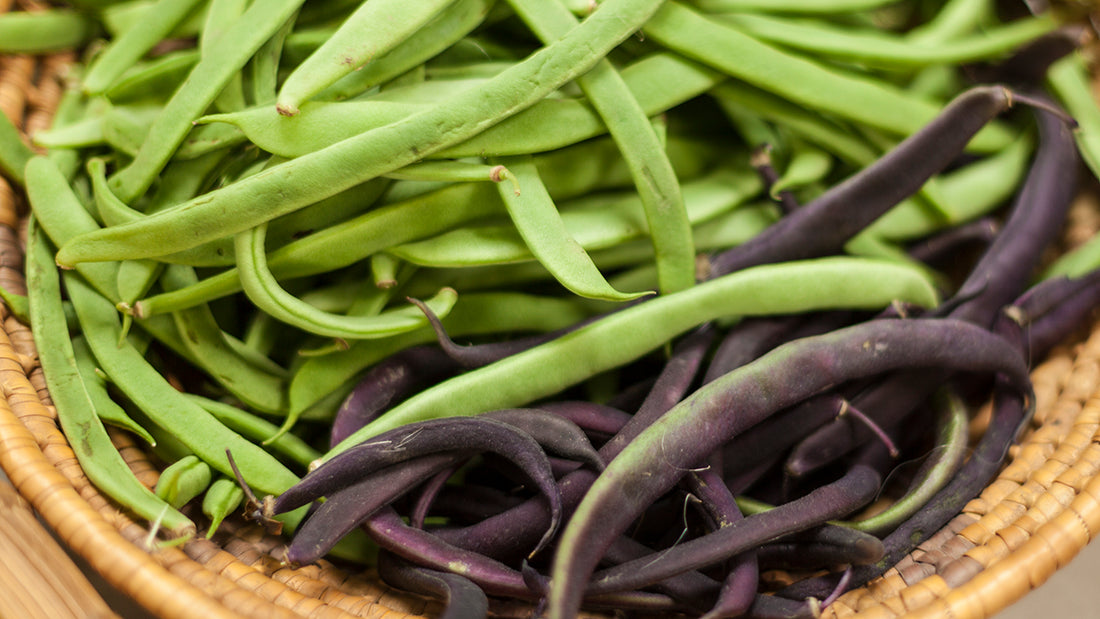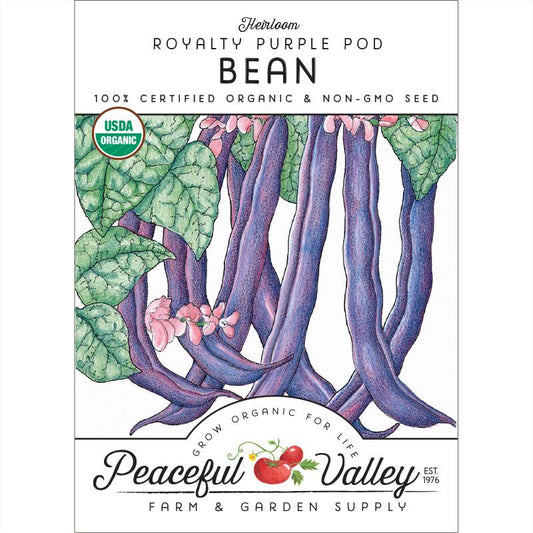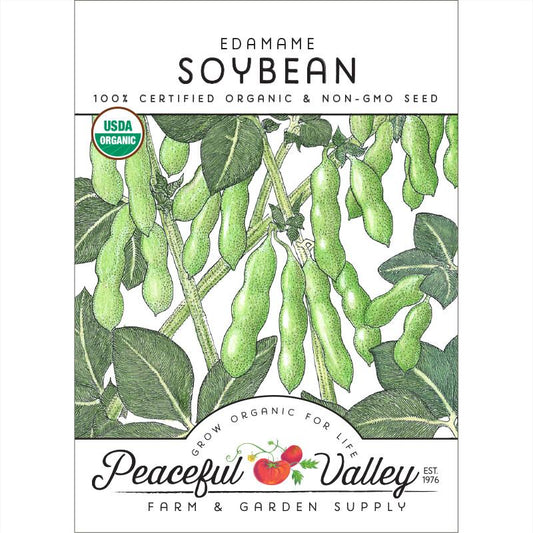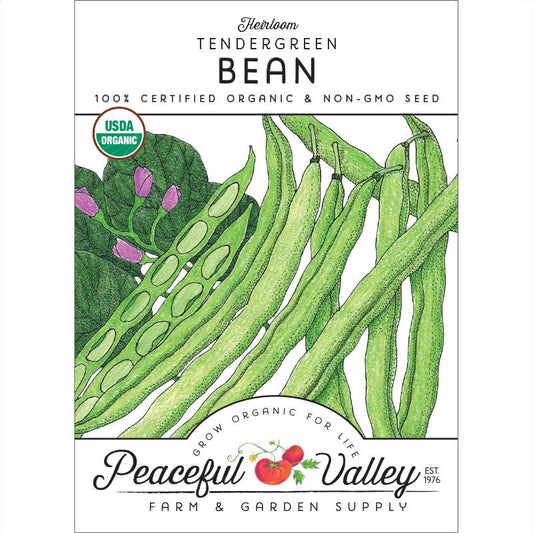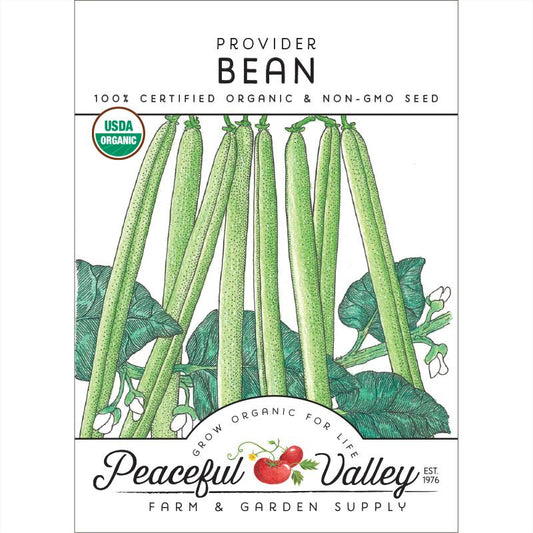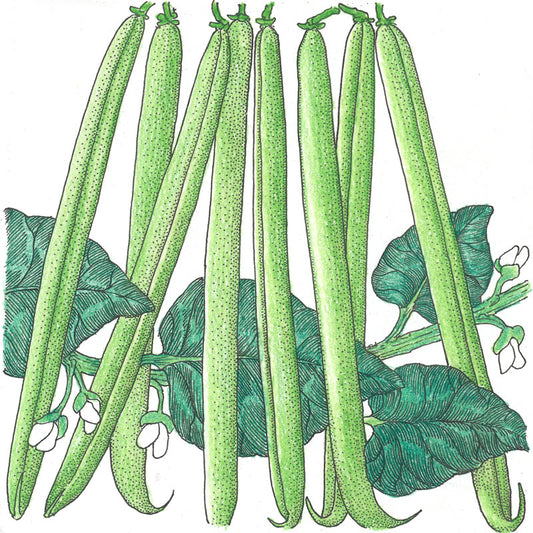Beans are a popular garden vegetable and can be separated to 3 groups – snap, shelling or dry bean. There are 3 basic growth habits of beans – bush, pole, or half-runners. Beans are legumes and if sufficient rhizobium soil bacteria is present (the proper strain), they can fix atmospheric nitrogen in small nodules found on their roots.
Bean Types

Broad: Broad beans are often shelled beans. An example is fava. Broad beans prefers cooler weather.
Bush: Bush beans do not need support. They produce earlier than pole varieties, but sets a determined amount of beans. Their flowers are formed at the end of branches. Bush beans can be grown as a continuous crop if planted successionally about every two weeks.
Dried: Dry beans ripen in pod prior to harvest for long term storage. An example is pinto beans.
Half Runners: Half Runner Beans have growth habits of both bush and pole beans. They do not grow as tall as pole beans.
Pole: Pole beans require trellis or other support. They have indeterminate growth, meaning they produce beans over a longer period than bush beans. The flowers are formed in leaf axils. They twine around supports in a counter-clockwise direction. Pole beans tolerate hot dry weather better than others.
Runner: Runner beans are an ancestor of the modern pole bean, with long pods and seeds. They twine around supports in a clockwise direction. Runner beans grow better in cooler climates. An example is Painted Lady.
Shell: Shell beans are edible seeds. The pod must be removed before eating (such as soy or lima beans).
Snap: Snap beans have pods and the immature seeds within are eaten. An example is Italian Snap Pole Beans.
Yard Long: Yard Long Beans are subtropical Asian varieties. They require hot day and night temperatures. Harvest the pods when they are about pencil thickness. And example is Red Yard Long.
Growing Basics
Soil: Beans prefer a soil pH around 6.5. Try growing tomatoes in some of our Peaceful Valley Organics Potting Soil; it is an excellent, organic all-around mix.
Temperature: Beans prefer temperatures of 70-80°F (above 60°F for germination). They tolerate 40-80°F (night temperatures can affect bloom set).
Seed longevity: If properly stored, the seeds should be viable for at least 3 years.
Companion Planting:
- Incompatibility – basil, kohlrabi, onions, fennel
- Companions – carrots, cucumbers, cabbage, lettuce, peas, rosemary, parsley
Water requirements: Beans like consistent moisture. Do not overhead water beans; instead use drip irrigation. Use mulch to conserve water. Excess humidity will increase pests and disease issues; space further apart for good air circulation.
Fertilization: Excess nitrogen will create excess foliage to the detriment of pod formation. Inoculating seeds with Rhizobium bacteria may increase yields. A low nitrogen fertilizer is suggested if soils are deficient. Address amendments prior to transplanting beans into your garden; supplement per product label. Weekly waterings of kelp will assist with plant strength.
Planting & Growing

Seed Sowing: Sow bean seeds directly in garden bed after frost has consistently past and the soil has warmed to at least 60°F. If the soil is not warm enough the bean seeds will not germinate and may rot. Choose a sunny area and amend the soil with compost so that surface will not crust and hinder emergence of seed sprout. Beans do not transplant well. If started indoors, use a biodegradable pot and transplant out with care.
Optional: Prior to planting, coat seeds with a nitrogen-fixing Rhizobium bacteria, such as our Garden Combination Mix Inoculant. This will allow the plants to fix nitrogen into the soil and may improve yield.
If planting bush beans, sow in succession approximately every 2 weeks (through August) for a continual harvest. Space seeds 2–4” apart in rows at least 18–24” apart.
If growing pole or yard long beans, erect a trellis for the plants to grow up. If using a teepee made from bamboo (6–7’), plant the seeds on the outside of the support in a circle. Spacing of seeds should be 4–6” apart about 6–8” from the poles. Check out the Cane Connectors to help you make a teepee.
Harvesting
Pick beans often to extend season. Snap beans (or green beans) should be immature so that seeds are still small and the pod snaps. Store harvested beans in a moisture proof, air tight container in the refrigerator. Beans are best eaten within 4 days of harvest.
Shell beans should be picked when the beans inside the pod have enlarged and the pods are thin and tough, but not dry.
Dried beans may be eaten at young snap or shell stage as well. They most likely have strings in the pod and it should be removed before eating. For storage wait until most all leaves are dead and pods are dry and beans rattle inside. If rain is in the forecast, pull up the entire bean plant and hang it indoors until the seeds are dry. Remove the dried beans from dried pod before storing.
Common Pests & Diseases

Aphid: Colonize on stems and leaves and extract sap. Spread other diseases to plants. Use yellow sticky traps, green lacewings and ladybugs, or an organic insecticide labeled for aphids.
Blight: Brown spots on leaves or pods with yellow edges. Occurs due to excessively wet and/or humid conditions.
Blossom Drop: Too much nitrogen or very high heat.
Cut Worms: Can use foil collars around the base of the plants (at soil level).
Corn Earworm: All parts of plant are susceptible to damage. Pest is usually visible at most stages or eggs on upper and lower leaf surfaces. Traps, beneficial insects or an organic insecticide labeled for corn earworms.
Leaf Spot: Leaves with irregular brown lesions. Can progress to shot hole where areas brown and drop. Use an organic fungicide labelled for leaf spot.
Mexican Bean Beetle: Skeletonized leaves. Handpick them off or use an organic insecticide labelled for Mexican Bean Beetles.
Mosaic: Mottled color pattern on leaves and stunted growth. Can be spread by aphids. May be a sign of nutritional deficiency.
Spider Mites: Can be washed with a strong stream of water (our Bug Blaster Spray Nozzle works great), or use an organic insecticide labeled for spider mites.
Pest Control – IPM
Integrated Pest Management (IPM) is an effective and environmentally sensitive approach to pest management that starts with the least invasive or impactful control methods and considers the use of chemical controls as the last step. For more information watch our Integrated Pest Management video.
Important to practice good cultural controls for pest management of beans. Cultural controls such as removing plants after harvest (to avoid leaving food for insects to continue to multiply on), practice crop rotation (i.e. do not plant crops in same family, in the same area for 3 years), use row covers such as Agribon AG15 (cover before insects arrive or to protect against birds when plants are young).
Common Questions
How are dried beans harvested? When beans rattle inside the dry pods, the pods can be removed. If rains or frost is expected before the pods have dried, the plant may be cut down and placed in a shed or barn to dry. If the beans are not thoroughly dry, leave them on a screen in shed or barn to do so before storage.
Storage should be in airtight containers placed in a cool, dry location out of the light. Freezing before storage will kill any pests that may have been present. It is best to eat stored beans within first year of harvest.
How much support do pole varieties require? Beans can be accommodated with a trellis at least 6 feet in height (above ground; more to stabilize in soil). It can be made as single stakes, arranged as teepees or use Jute or Hortonova trellis supported by stakes. Be sure to have enough space between plants to allow for adequate air circulation. This will help prevent some pests and diseases.
Do beans require abundant pollenizers to be present? Most bean species take care of this essential process before their bloom opens, hence they are self-pollinating. However, yields may be higher with the help of bees and other insects.
Definitions
Heirloom: Heirloom seeds come from open-pollinated plants that pass on similar characteristics and traits from the parent plant to the next generation plant. Heirloom vegetables are old-time varieties generally which have been in production since before WWII, and have been saved and handed down through multiple generations.
Hybrid: a cross between two or more unrelated plant varieties. The two different varieties are cross bred, resulting in a seed that carries one or more favorable traits (increased yield, uniformity, color, disease resistance.) Hybrid seeds are not GMO, as they are manually cross-bred, not genetically modified in a lab. Hybrid seed is often sterile or does not reproduce true to the parent plant. Therefore, never save the seed from hybrids.
Open Pollinated: generally refers to seeds that will “breed true.” When the plants of an open-pollinated variety self-pollinate, or are pollinated by another representative of the same variety, the resulting seeds will produce plants roughly identical to their parents. Genetic traits may differ only slightly due to variations created by local conditions.
GMO: Genetically Modified Organisms were genetically modified in a laboratory where DNA genes are extracted and mixed with other unrelated plants to improve characteristics. Saved seed will not always be viable and may be trademarked to prevent unauthorized use.

